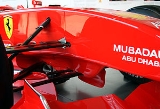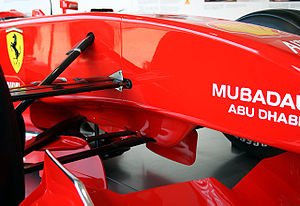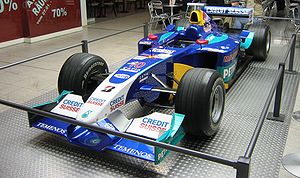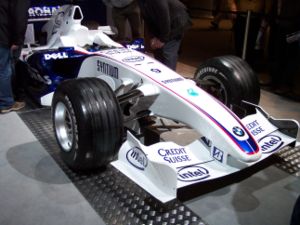
Suspension keel
Encyclopedia
A suspension keel is an extension pylon to the bodywork of single-seat, open wheel racing cars
designed with a raised nose cone
, to allow the lower suspension arms
to be attached to the car approximately parallel to the road surface. In recent years the placing and design of a suspension keel, or the lack of such, has been one of the few distinct variables in Formula One
chassis design.
Traditional low nose cone designs (e.g. the McLaren MP4/4
) allow the lower suspension arms to be directly attached to the main structural members of the car. However, since the move to high nose cone designs - which allow better use of airflow underneath
the car, and to a lesser extent the front wing
- location of these lower arms has proven problematic. For ideal suspension geometry, and hence maximum mechanical grip
, the lower arms should be long and near parallel with the road. As there is no longer any structural bodywork in these low positions, extensions were developed to allow the suspension to be mounted with correct geometry. Since the advent of high nose designs in the early 1990s, pioneered on the Tyrrell 019
Formula One car, three major keel designs have emerged to solve this problem:



 One limitation of any keel design is that, while the keel influence may vary, the suspension linkages themselves still disrupt the underbody airflow. This problem was exacerbated when the FIA introduced rule changes in that forced teams to mount their front wing in a more elevated position. In response to this, many F1 teams have developed zero-keel chassis designs. Here the keel is removed entirely, and the suspension is mounted directly to the chassis. As the nose cone is in a raised position, this entails that the suspension arms take a distinctly inclined angle with respect to the road surface, reducing suspension efficiency. However, with continued restrictions to aerodynamic downforce
One limitation of any keel design is that, while the keel influence may vary, the suspension linkages themselves still disrupt the underbody airflow. This problem was exacerbated when the FIA introduced rule changes in that forced teams to mount their front wing in a more elevated position. In response to this, many F1 teams have developed zero-keel chassis designs. Here the keel is removed entirely, and the suspension is mounted directly to the chassis. As the nose cone is in a raised position, this entails that the suspension arms take a distinctly inclined angle with respect to the road surface, reducing suspension efficiency. However, with continued restrictions to aerodynamic downforce
through the use of aerofoil
wings, and the lighter V8 engines specified from 2006 onwards causing weight distribution to shift forward, many designers apparently consider this drawback to be less significant than the concomitant increase in venturi
downforce generated underneath the car; except for Renault and Red Bull, all of the teams in the 2007 Formula One World Championship used a zero-keel design.
Racing Cars
Racing Cars are a Welsh pop band, formed in the Rhondda Valley, Wales in 1973.-Career:They were signed to one of the biggest British record labels of the time, Chrysalis Records. Racing Cars's debut album yielded their only hit single with "They Shoot Horses, Don't They?"...
designed with a raised nose cone
Nose cone
The term nose cone is used to refer to the forwardmost section of a rocket, guided missile or aircraft. The cone is shaped to offer minimum aerodynamic resistance...
, to allow the lower suspension arms
Double wishbone suspension
In automobiles, a double wishbone suspension is an independent suspension design using two wishbone-shaped arms to locate the wheel. Each wishbone or arm has two mounting points to the chassis and one joint at the knuckle. The shock absorber and coil spring mount to the wishbones to control...
to be attached to the car approximately parallel to the road surface. In recent years the placing and design of a suspension keel, or the lack of such, has been one of the few distinct variables in Formula One
Formula One
Formula One, also known as Formula 1 or F1 and referred to officially as the FIA Formula One World Championship, is the highest class of single seater auto racing sanctioned by the Fédération Internationale de l'Automobile . The "formula" designation in the name refers to a set of rules with which...
chassis design.
Traditional low nose cone designs (e.g. the McLaren MP4/4
McLaren MP4/4
The McLaren MP4/4 was a highly successful Formula 1 car that competed in the 1988 Formula One season. It was designed by Gordon Murray, who based the design on his lowline Brabham BT55 car of 1986, and American engineer Steve Nichols. It is one of the most dominant Formula One cars ever built,...
) allow the lower suspension arms to be directly attached to the main structural members of the car. However, since the move to high nose cone designs - which allow better use of airflow underneath
Diffuser (automotive)
A diffuser, in an automotive context, is a shaped section of the car underbody which improves the car's aerodynamic properties by enhancing the transition between the high-velocity airflow underneath the car and the much slower freestream airflow of the ambient atmosphere...
the car, and to a lesser extent the front wing
Downforce
Downforce is a downwards thrust created by the aerodynamic characteristics of a car. The purpose of downforce is to allow a car to travel faster through a corner by increasing the vertical force on the tires, thus creating more grip....
- location of these lower arms has proven problematic. For ideal suspension geometry, and hence maximum mechanical grip
Car handling
Automobile handling and vehicle handling are descriptions of the way wheeled vehicles perform transverse to their direction of motion, particularly during cornering and swerving. It also includes their stability when moving at rest. Handling and braking are the major components of a vehicle's...
, the lower arms should be long and near parallel with the road. As there is no longer any structural bodywork in these low positions, extensions were developed to allow the suspension to be mounted with correct geometry. Since the advent of high nose designs in the early 1990s, pioneered on the Tyrrell 019
Tyrrell 019
The Tyrrell 019 was a Formula One racing car, designed by a team led by Harvey Postlethwaite, and built by Tyrrell. It was an evolution of Postlethwaite's first design for Tyrrell, the Tyrrell 018....
Formula One car, three major keel designs have emerged to solve this problem:

- Single-keel: Perhaps the simplest response, utilising a single, planar extension to the ventral surface of the car's nose cone, providing a plate onto which the proximal ends of the suspension arms can be mounted. Benefits include a simple construction design, and the flexibility of having a large surface, thus allowing the suspension geometry to be altered for fine tuning. A serious hindrance in the single-keel design is that the keel itself protrudes into the underbody airflow, thus reducing the benefits of the raised nose design. As a consequence of this the single keel design fell out of favour in the late 2000s. However, for the 2010 Formula One season2010 Formula One seasonThe 2010 Formula One season was the 61st Formula One season of World Championship motor racing competition. Red Bull Racing won its maiden Constructors' Championship with a one-two finish in Brazil, while Red Bull Racing's Sebastian Vettel won the Drivers' Championship after winning the final race...
both the Mercedes MGP W01Mercedes MGP W01The Mercedes MGP W01 was a Formula One motor racing car designed and built by the Mercedes GP Petronas team for the season and was driven by the returning seven-time World Champion Michael Schumacher and Nico Rosberg. The car was revealed at the Circuit Ricardo Tormo near Valencia at the first...
and Virgin VR-01Virgin VR-01The Virgin VR-01 was a Formula One motor racing car designed by Nick Wirth for Virgin Racing in the season. It was driven by former Toyota driver Timo Glock and Brazilian ex-GP2 driver Lucas di Grassi. The car was the first Formula One racing car designed entirely with computational fluid dynamics...
feature single keel front suspension.

- Twin-keel: As the name suggests, rather than one single keel, two shorter keel stubs are used. Each protrudes from the underside or lower corners of the nose cone, and the left and right suspension arms are mounted to the appropriate keel. This design reduces the disturbance to the airflow, but compromises the suspension set up and configuration flexibility, and introduces significant structural complexity and weight. The twin-keel concept was conceived by Harvey PostlethwaiteHarvey PostlethwaiteHarvey Postlethwaite was a British engineer and Technical Director of several Formula One teams during the 1970s, 1980s and 1990s. He died of a heart attack in Spain while supervising the testing of the abortive Honda F1 project...
during his time at Honda Racing Developments, before being introduced by SauberSauberSauber F1 Team is a Swiss Formula One team. It was founded in the 1970s by Peter Sauber, who progressed through hillclimbing and the World Sportscar Championship to reach Formula One in 1993....
during the 2000 Formula One season2000 Formula One seasonThe 2000 Formula One season was the 51st season of FIA Formula One motor racing. It featured the 2000 FIA Formula One World Championship which commenced on March 12, 2000, and ended on October 22 after seventeen races...
and swiftly copied by many other teams. In , only Red Bull RacingRed Bull RacingRed Bull Racing is a Formula One racing team based in Milton Keynes, England which currently holds an Austrian licence. It is, along with Scuderia Toro Rosso, one of two teams owned by beverage company Red Bull GmbH. The team have won two Constructors' Championship titles, in and , becoming the...
used a twin-keel chassis.

- V-keel: Used principally by the Renault F1Renault F1Lotus Renault GP, formerly the Renault F1 Team, is a British Formula One racing team. The Oxfordshire-based team can trace its roots back through the Benetton team of the late 1980s and 1990s to the Toleman team of the early 1980s. Renault had also competed in various forms since , before taking...
team, who introduced the design in , this variant uses two keel elements protruding downward in a V shape. The tips of the elements are fused, and at this point the suspension arms are mounted. Something of a compromise position, benefits include a reduction in disturbance to the underbody airflow in comparison to a single-keel design, with fewer geometry restrictions than with twin-keels.

Downforce
Downforce is a downwards thrust created by the aerodynamic characteristics of a car. The purpose of downforce is to allow a car to travel faster through a corner by increasing the vertical force on the tires, thus creating more grip....
through the use of aerofoil
Airfoil
An airfoil or aerofoil is the shape of a wing or blade or sail as seen in cross-section....
wings, and the lighter V8 engines specified from 2006 onwards causing weight distribution to shift forward, many designers apparently consider this drawback to be less significant than the concomitant increase in venturi
Venturi effect
The Venturi effect is the reduction in fluid pressure that results when a fluid flows through a constricted section of pipe. The Venturi effect is named after Giovanni Battista Venturi , an Italian physicist.-Background:...
downforce generated underneath the car; except for Renault and Red Bull, all of the teams in the 2007 Formula One World Championship used a zero-keel design.

